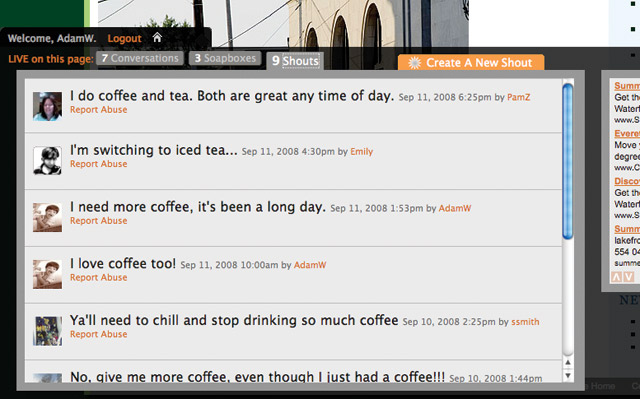
LiveWorld is a publicly traded company that’s been around since 1996 and is best known for its white labeled social networks. These are online communities that LiveWorld helps clients build up around their existing brands, and they often take a good deal more time and effort to set up than communities created on top of self-service platforms like Ning or KickApps.
However, LiveWorld is making a significant foray into “out-of-the-box” communities with the release of LiveBar, a widget-like site addition that brings community features to any website using only one line of JavaScript.
The LiveBar consists of a thin strip that sticks to the bottom of the browser window and displays social content related to the page. It’s reminiscent of Facebook Chat or the upcoming community instant messaging offering from Meebo. But instead of facilitating instant messages, the LiveBar shows three types of user contributions: Conversations, Soapboxes, and Shouts.
Conversations are essentially lightweight forum threads where users can post messages and solicit responses. Soapboxes are akin to blog posts and Shouts are like tweets in that they’re restricted to 140 characters. In the LiveBar’s simplest implementation, these pieces of UGC are associated with individual URLs, so when you move from one page to the next, you see different content.
However, they can also be tied together into so-called bundles so that discussions form across pages that relate to each other. The LiveBar can also be rolled out across multiple sites on different domains, with bundles providing social glue around pages and sites that were formerly fragmented.

The biggest downside to the LiveBar (which could also be seen as its greatest virtue) is its discreetness. Visitors are prone to overlook it entirely because it sits so low and short on the page. To combat this tendency, LiveWorld has developed a suite of widgets that hook the LiveBar into the actual page layout. The widgets can be used, for example, to print the most recent conversations or solicit new ones. I expect that most publishers will deploy these extra widgets to get the most bang for their buck. After all, the LiveBar isn’t free; like other LiveWorld services, it’ll cost you thousands of dollars just to get it up and running.
LiveWorld plans to add more flexibility and functionality to the LiveBar over time, with chat in particular on the way. This will put LiveWorld in direct competition with Meebo, although Meebo’s specialty in online instant messaging should make for a superior product.
Both Tulane University and A&E Biography already plan to use LiveBar on their respective sites.